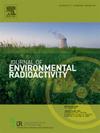喷灌下蔬菜的放射性核素转移
IF 2.1
3区 环境科学与生态学
Q3 ENVIRONMENTAL SCIENCES
引用次数: 0
摘要
本文介绍了喷灌条件下蔬菜放射性核素转移的新数据。实验是在北高加索地区进行的,这是一个集约化灌溉农业地区,使用常见的蔬菜作物,包括西红柿、黄瓜、胡萝卜、食用甜菜、洋葱、土豆和卷心菜。该研究使用了多种放射性核素59Fe, 60Co, 65Zn, 89Sr, 106Ru, 134Cs和144Ce。研究了元素特性、灌水量和灌溉水化学特性对作物体内放射性核素积累的影响。结果表明,喷灌条件下蔬菜作物营养组织中65Zn、144Ce和134Cs的积累量最大;65Zn、89Sr和134Cs在植物可食部位积累最多。灌溉量从10 L/m2增加到50 L/m2,植物组织中59Fe和134Cs浓度增加1.5 ~ 3.2倍,植物可食用部位59Fe和134Cs浓度增加1.2 ~ 3.3倍。本文还考虑了施用矿质肥料对灌溉条件下蔬菜放射性核素转移的影响。结果表明,灌溉时机和植株发育阶段是影响蔬菜作物放射性核素积累的关键因素。本文章由计算机程序翻译,如有差异,请以英文原文为准。

Radionuclide transfer to vegetables under sprinkler irrigation
The paper presents novel data on radionuclide transfer to vegetables under sprinkler irrigation. The experiments were conducted in the North Caucasus, a region of intensive irrigated agriculture, using common vegetable crops including tomatoes, cucumbers, carrots, table beet, onions, potatoes, and cabbage. The research utilized a wide range of radionuclides 59Fe, 60Co, 65Zn, 89Sr, 106Ru, 134Cs and 144Ce. The effects of element properties, irrigation rates, and the chemical characteristics of irrigation water on radionuclide accumulation in the crops were investigated. It was found that under sprinkler irrigation 65Zn, 144Ce, and 134Cs exhibit the highest accumulation in the vegetative tissues of vegetable crops; 65Zn, 89Sr and 134Cs show the greatest accumulation in the edible parts of the plants. Increasing the irrigation rate from 10 to 50 L/m2 leads to a 1.5– to 3.2-fold increase in the concentration of 59Fe and 134Cs in plant tissues and a 1.2– to 3.3-fold increase in edible parts of plants. The paper also considers effects of the application of mineral fertilizers as a factor regulating radionuclide transfer to vegetables under irrigation. It is shown that irrigation timing and plant development stage are key factors governing radionuclide accumulation in vegetable crops.
求助全文
通过发布文献求助,成功后即可免费获取论文全文。
去求助
来源期刊

Journal of environmental radioactivity
环境科学-环境科学
CiteScore
4.70
自引率
13.00%
发文量
209
审稿时长
73 days
期刊介绍:
The Journal of Environmental Radioactivity provides a coherent international forum for publication of original research or review papers on any aspect of the occurrence of radioactivity in natural systems.
Relevant subject areas range from applications of environmental radionuclides as mechanistic or timescale tracers of natural processes to assessments of the radioecological or radiological effects of ambient radioactivity. Papers deal with naturally occurring nuclides or with those created and released by man through nuclear weapons manufacture and testing, energy production, fuel-cycle technology, etc. Reports on radioactivity in the oceans, sediments, rivers, lakes, groundwaters, soils, atmosphere and all divisions of the biosphere are welcomed, but these should not simply be of a monitoring nature unless the data are particularly innovative.
 求助内容:
求助内容: 应助结果提醒方式:
应助结果提醒方式:


